It’s Tuesday again (time really flies), and today is exactly 2 weeks since I’ve left Phnom Penh (pronounced as per-nom pen in Khmer) and slightly more than a week since I set foot down under. Today I’ll be covering just 2 places of note in Phnom Penh – the Tuol Sleng Genocide Museum, otherwise known as the S-21 Prison, and the Choeung Ek Killing fields – both of which are sad reminders of the Khmer Rouge regime in Cambodia. It is more than possible to visit both these places within half a day, since the tour of the prison takes about 2-3 hours, followed by a 40 minute bus ride to the Killing fields, and another 2 hour tour there. Also, don’t be stingy and skimp on having a tour guide – having a tour guide really helps, and their fees are really low in Phnom Penh – it’s about US$25 for an entire day of guiding you around! I’d definitely recommend visiting Cheung Ek after you have visited the Genocide Museum, to get better insights into the Khmer Rouge regime.
Ever wondered why the name Khmer Rouge? Well, Rouge is basically red in French, and the ruling party during the Khmer Rouge regime was the Communist Party of Kampuchea, and as we know, the color red is usually associated with communist regimes – think Mao and his red flag.
So we visited Tuol Sleng early in the morning. This was the infamous S-21 prison during the Khmer Rouge, and it was formerly a school. Thousands of people were tortured here, before being shipped off in the truckloads to Choeung Ek to be killed. Only 8 prisoners made it out alive from this prison, and their testimonies are written on some of the exhibition panels. I guess what's most shocking is how small this prison was, and yet it contained at least 1,500 people at any one time during the Khmer Rouge Regime.
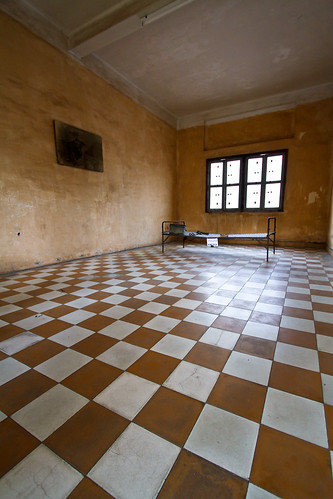 |
| A seemingly empty classroom, but the bed frame and the box on it contains torture devices used to torment the prisoners. |
Also shocking are the atrocities that Khmer Rouge managed to commit during their four-year reign of terror. The exact number of people who died unclear, but from rough estimates and from what the tour guide told us, pre-1979, Cambodia had about 5 million people in total; post- 1979, 3 million people were left, so do your math.
For those interested, Comrade Duch - best known for running this S-21 prison, was convicted by the Cambodian Special Court to 35 years' imprisonment for crimes against humanity, murder and torture he committed during 1975-9. Many Cambodians don't think it fair that he be imprisoned for so short a time, but Cambodia no longer has the death penalty (unlike Singapore). Also, many Cambodians appear to want to leave the four years as it is, a horrific reminder of what a fellow Cambodian can do to his people, and many want to let it be water under the bridge. Well.
After a few grim hours walking in Tuol Sleng (the tour guide will guide you through the different classrooms and buildings - there are 3 in total, each with different 'functions'), we took a bus to Choeung Ek. You can also take a tuk-tuk there if there's just a few of you.
 When you head to Choeung Ek, the first thing you see is this tall towering Buddhist stupa standing tall and alone. On its side t is another traditional building - this houses the museum which screens a documentary at regular intervals, explaining more about the Khmer Rouge regime and its atrocities. The stupa is 62 meter tall, 17 storeys high. According to my tour guide, it has over 8000 human skulls, and many other body parts, and each storey contains different body parts uncovered at each site. The bottom few storeys contain clothing garments and other objects found together with the corpses - all of which were chemically treated in 1988 when the stupa was built, to preserve them.
When you head to Choeung Ek, the first thing you see is this tall towering Buddhist stupa standing tall and alone. On its side t is another traditional building - this houses the museum which screens a documentary at regular intervals, explaining more about the Khmer Rouge regime and its atrocities. The stupa is 62 meter tall, 17 storeys high. According to my tour guide, it has over 8000 human skulls, and many other body parts, and each storey contains different body parts uncovered at each site. The bottom few storeys contain clothing garments and other objects found together with the corpses - all of which were chemically treated in 1988 when the stupa was built, to preserve them. This stupa was built in 1988, as a memorial, to remind the later generations of Cambodians, as well as visitors from around the world, of the terror that these victims went through. The building of the stupa is also significant, because Cambodians are a deeply religious lot, and many were troubled that these victims were not given a proper Buddhist send-off into the other world. This stupa allow for the Buddhist funeral rites to be performed to allow the spirits to peacefully transit into the afterlife. Furthermore, stupas are sacred structures in Buddhism - they are meant to contain remains of greatly revered individuals. You can't see from the photo, but the sides of the stupa are glass-walled, so that you may look into the stupa and see the dozens and hundreds of human skulls looking eyelessly out at you.
 |
| Dozens and dozens of human skulls - some with fractures from being killed by a fatal blow, some with holes from being killed by a pickaxe, and more. |
It is at Choeung Ek that the tortured prisoners from the S-21 prison was brought. There have been tons of mass graves found, and many more yet to be uncovered (approximately 50 more). Prisoners were forced to kneel at the edge of a pre-dug pit, with their eyes blindfolded and their hands tied behind their backs. Then, they were killed, with the method favored by the soldier(s) at the pit. Simple implements were used to kill, because the soldiers did not want to waste bullets. For example, the branch of the palm tree, with its razor sharp edges, was used to slice a prisoner's neck from ear to ear. Another method for disposing of children was a tree trunk found in the area (as seen below). These children would be lifted by their arms or legs, and the soldiers would continually bash their skulls against the tree trunk, until they died. Talk about improvising with what they had huh?
While walking around Choeung Ek, I felt that more could be done to preserve the items - for instance, scraps of clothing found post-1988 are merely placed in glass tanks around the pits. They are not placed in the stupa because those items are chemically treated. This means that in a few more decades, these scraps of clothing would most likely turn into dust. Admittedly, Choeung Ek as a memorial, is less well-done than places like the concentration camps in Germany, some of which I've been to, but it does not make it any less grim. What I brought home from the trip was that Cambodia does need funds urgently - the reason why items or skulls found post-1988 are not chemically treated to preserve them is because funds are not sufficient for these activities.
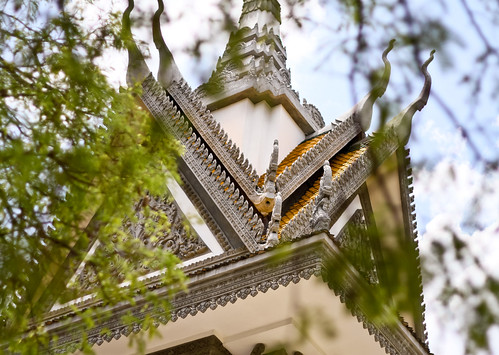 |
| A last look at the stupa in Choeung Ek |
It is only after you visit Toul Sleng and Choeung Ek that you realize why Cambodia is at the stage it is now, why it continues to be so undeveloped when its neighbours Thailand and Vietnam are racing ahead. The Khmer Rouge regime really did devastate it. In fact, an interesting observation was that in my 3 weeks in Cambodia, I only saw 3 really old people - people whom I’d tag as about 70 years and above, people who were wrinkled and hunchbacked. Everyone else is young, probably around 50 years old or less. This was because so many people, especially scholars and other skilled people, were killed during those 4 years. Cambodia really did start from Ground Zero starting 1979. All its scholars and professionals were killed. One can't help but feel the pain that Cambodians feel when visiting these sites.
On a lighter note, there are other places of interest in Phnom Penh, such as the Royal Palace and the Wat Phnom, both of which deserve a visit too, but I’ll leave that for another post. Also, unknown to many, Phnom Penh actually has really good shopping – I managed to get things like scarves for about US$2-3, and shirts for less than US$5 each! And they are of pretty good quality, mind you! For those contemplating a trip somewhere in Southeast Asia, please don’t write off Cambodia - I believe it is still an undiscovered pearl, and as a nation, it so very needs our help, in terms of our tourist dollar and our donations, if you are so inclined. Do put Phnom Penh (and Siem Reap) in your to-go-to places today!
PS: It really is worth the 6-hour bus ride to head down to Siem Reap just to see Angkor Wat.

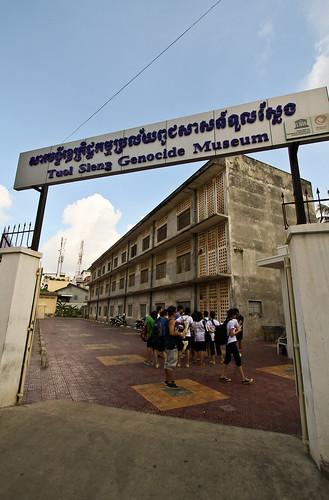


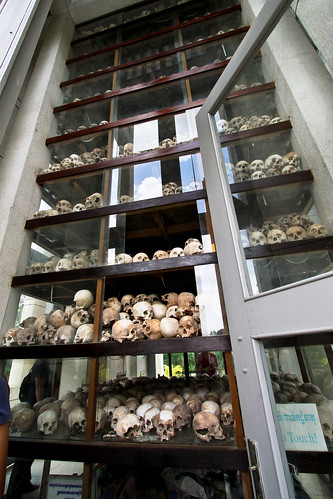


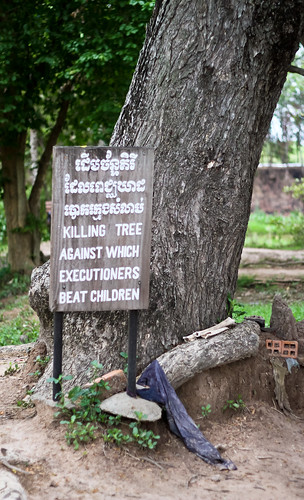
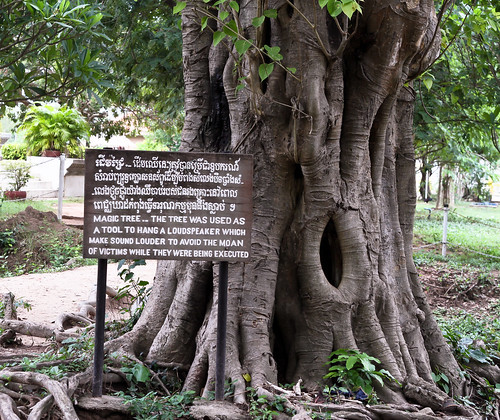
4 comments:
We were in Siem Reap in Jan this year... We loved the place ....Highly recommended place to visit. People are friendly n polite...n toilets are super clean... would go again if good deal comes our way ...
Beautiful click n read
A real eye opener post! Hope to visit one day
wow, the photos are really disturbing. I especially love the one with one steel-framed bed and chessboard-tiled flooring. A lot of impact!
I'd been wanting to go Cambodia for eons now but my other half is not too keen unfortunately. looks like i'd gotta work harder to persuade!
@Lisa: Yup I found the toilets pretty clean as well! I liked Siem Reap too, but Phnom Penh was where I left my heart :)
@Jeannie: It's worth a visit!
@Alan: Thanks for the comments Alan :D Oh do work harder to persuade the other half! If it floats her boat, tell her that the shopping is really good in Phnom Penh and Siem Reap - I went with 10 other girls and ALL of us went crazy at the night markets and day markets. The architecture and culture and food is also sufficiently distinctive (although it does share many similarities with Thailand) :)
Post a Comment